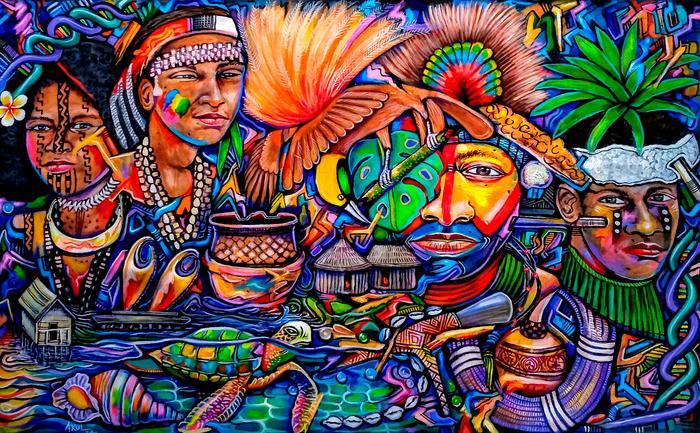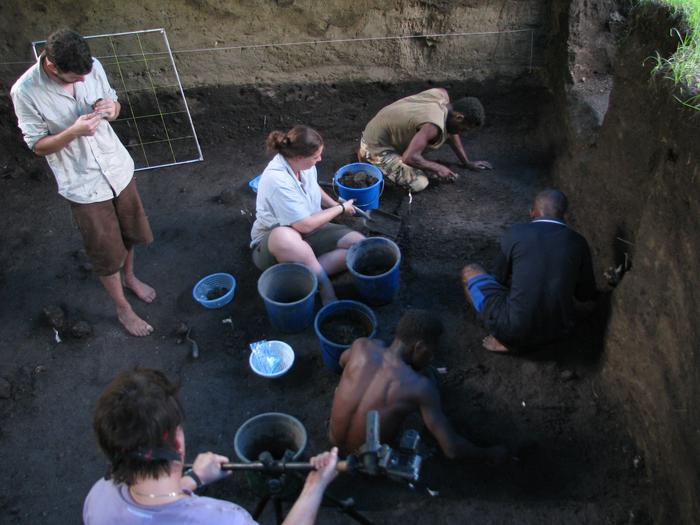2.500 years of human and genetic history of coastal Papua New Guinea
A new study reveals the significance of regional dispersals and local interactions in coastal Papua New Guinea
To the point
- 2.500 years of human history in Papua New Guinea: The first ancient genomes, dietary isotopes and plant microfossils from Papua New Guinea and the Bismarck Archipelago provide direct genetic evidence that refines our understanding of early dispersals and population interactions in the Pacific.
- Distinct interactionspheres in the past and present: The study found that 2,000 years ago, different cultural and genetic groups inhabited the region for extended periods without mixing. The mosaic of cultures and languages today perhaps emerged 650 years ago, when networks reorganized after an environmentally challenging period. The new findings shed light on the complex settlement history and regional divergence among ancient communities.
- Interdisciplinary approach: Combining ancient DNA, archaeology, and linguistics provides a more complete picture of how genetics, culture and environment influenced the rich diversity of Pacific societies.
Combining ancient DNA with dietary evidence and linguistics, the study paints a vivid picture of the pre-colonial coastal communities that once thrived in these lands. New Guinea, settled over 50,000 years ago, served as a vital launch point for early seafaring journeys into the wider Pacific—an epic chapter in human history marked by extraordinary navigational feats.

The Lapita cultural complex and early Pacific pioneers
Roughly 3,000 years ago, the Bismarck Archipelago became the cradle of the Lapita cultural complex, whose seafaring peoples, renowned for their intricate pottery and horticultural practices, and embarked on voyages that would reach as far as Vanuatu, Tonga, and Samoa. Yet until now, the genomic legacy of these early Pacific pioneers—and the islands they first called home—had remained unexplored.
“Our findings represent a significant milestone in our understanding of the genetic history of Papua New Guinea,” says Dylan Gaffney, Archaeologist and co-author of the study. “For the first time, we have direct genetic evidence from ancient individuals, allowing us to refine our understanding of the Pacific past.”
Co-existence in the Bismarck Archipelago
One of the study’s most striking findings is the presence of individuals with completely Papuan genetic signatures on the island of Watom in the Bismarck Archipelago, where missionaries found the very first Lapita-style pottery in the early 20th century. The individuals excavated on the island are all younger than evidence for the arrival of the Lapita Cultural Complex. One of these individuals additionally displays a rare case of cultural cranial modification, suggesting the co-occupation of the island by genetically and culturally different groups.

Delayed mixing
The study also highlights the influence of migrations and interactions on the genetic makeup of ancient communities. From around 2100 years before present, the genetic profiles of individuals show varying degrees of genetic contributions associated with the arrival of the Austronesian expansion.
“Our analysis reveals a fascinating picture of the earliest encounters in the Bismarck Archipelago,” explains Co-lead author Rebecca Kinaston. “Despite the co-occupation, it seems the different groups didn’t mix for a long time, which is quite unusual for human encounters.”
The delay in intermarriage and the presence of people with Papuan ancestry inform on a debated matter in Pacific human history: Did the first settlers in the remote islands of Western Remote Oceania arrive unmixed and, followed by people from New Guinea, mix on the islands? The new findings support previous studies, suggesting this is a likely scenario, and informing on the seafaring capabilities of Papuan ancestors.
Settlement of the Mariana Islands
One individual adds resolution to questions on the settlement of the Mariana Islands to the north of Papua New Guinea. Their genetic profile suggests the Mariana Islands were likely settled from Island Southeast Asia. This route, which required sailing against prevailing winds and currents, excludes the easier passage from islands northeast of New Guinea.
“Despite some uncertainty due to a lack of ancient samples from the Philippines and Taiwan, our findings highlight the remarkable navigation skills of the early settlers of the Mariana Islands,” says Cosimo Posth, one of the study’s authors.
The analysis of two geographically close communities inhabiting the South Coast of Papua New Guinea between 500 and 150 years ago proved to be particularly interesting. Surprisingly, their ancestries started diverging 650 years ago, despite the absence of geographical borders. This divergence suggests the communities were shaped by distinct interaction spheres and cultural influences, with implications for our understanding of ancient trade networks and social dynamics.
Role of the environment in cultural diversification
“Our research highlights the intricate interplay between genetics, culture, and environment in shaping human history,” says Johannes Krause, Director at the Max-Planck Institute for Evolutionary Anthropology. “The genetic split coincides with a time of increased settlement activity and the emergence of regional trade networks after a climatically challenging period and highlights the role environmental factors might play in cultural diversification.”
The recovery of ancient DNA from Papua New Guinea represents a remarkable feat, considering the challenges posed by the region’s climate and terrain. The hot and humid tropical climates are detrimental to the preservation of organic material, including DNA. At the same time, multiple colonial invasions impacted these regions’ cultural, genetic, and linguistic landscape. Investigating Papua New Guinea’s human history through ancient genomes offers a glimpse into the hidden past of this culturally diverse and historically rich region.
Interdisciplinary approach
“This study underscores the importance of interdisciplinary collaboration in unraveling the mysteries of human history,” concludes lead-author Kathrin Nägele. “By combining archaeological data with cutting-edge genetic analysis and considering oral traditions, we can reconstruct a more comprehensive picture of our shared past.”
The publication of these ancient genomes marks a significant step forward in our understanding of the genetic diversity and historical dynamics of Papua New Guinea. It invites further exploration and investigation, promising new revelations about the origins of the cultural and linguistic diversity of the diverse communities in the Pacific region.
Press release from the Max-Planck Institute for Evolutionary Anthropology
Otago researchers help unlock ancient migration secrets
University of Otago – Ōtākou Whakaihu Waka researchers have helped bring clarity to the great migration of early Pacific pioneers, considered to be ancestors of many Pacific people including Māori.
In a new study published in Nature Ecology and Evolution, a group of international researchers involving several from Otago have recovered the first ancient genomes (aDNA) from Papua New Guinea and the Bismarck Archipelago – unlocking genetic insights from a region as culturally rich as it is historically pivotal.
Combining aDNA with dietary evidence and linguistics, the study reveals how the pre-colonial coastal communities were surprisingly genetically diverse from each other and suggests many cultural groups did not intermarry for some time.
Co-author Dr Monica Tromp from Southern Pacific Archaeological Research, in the Archeology Programme, says aDNA acts like a time machine, revealing how people lived and interacted thousands of years ago – and how those ancient connections still influence our world today.
“This groundbreaking research reveals something remarkable: Pacific Island cultures were far more diverse and complex than we ever imagined.
“Rather than being one unified group, these ancient communities represented a rich tapestry of different cultures and peoples.”
New Guinea, settled over 50,000 years ago, served as a vital launch point for early seafaring journeys into the wider Pacific – a chapter in human history marked by extraordinary navigational feats.
About 3,300 years ago, the Lapita people – considered the earliest ancestors of many Pacific people, including Māori – settled in the Bismarck Archipelago, which became the cradle of the Lapita cultural complex.
The seafaring peoples were renowned for their intricate pottery and horticultural practices and embarked on voyages that would reach as far as Vanuatu, Tonga, and Samoa.
Yet until now, the genomic legacy of these early Pacific pioneers – and the islands they first called home – had remained unexplored, Dr Tromp says.
“They were some of the world’s greatest explorers and navigators, setting sail into the endless blue horizon centuries before Europeans ever dared venture far from their own coastlines.”
What makes the study particularly exciting is that it shows how far scientific technology has advanced, she says.
“The DNA analysis that made these discoveries possible would have been completely impossible just a decade ago.
“Hot, humid tropical climates typically destroy genetic material, but new techniques have opened up entirely new chapters of human history that were previously lost to us.”
One of the study’s most striking findings is the presence of individuals with completely Papuan genetic signatures on the island of Watom in the Bismarck Archipelago, where missionaries found the very first Lapita-style pottery in the early 20th century.
The individuals excavated on the island are all younger than evidence for the arrival of the Lapita Cultural Complex. One of these individuals additionally displays a rare case of cultural cranial modification, suggesting the co-occupation of the island by genetically and culturally different groups.
Co-lead author Dr Rebecca Kinaston, from BioArch South, says the researchers’ analysis reveals a fascinating picture of the earliest encounters in the Bismarck Archipelago.
“Despite the co-occupation, it seems the different groups didn’t mix for a long time, which is quite unusual for human encounters.”
The delay in intermarriage and the presence of people with Papuan ancestry inform on a debated matter in Pacific human history: Did the first settlers in the remote islands of Western Remote Oceania arrive unmixed and, followed by people from New Guinea, mix on the islands?
The new findings support previous studies, suggesting this is a likely scenario, and informing on the seafaring capabilities of Papuan ancestors, Dr Kinaston says.
The analysis of two geographically close communities inhabiting the South Coast of Papua New Guinea between 500 and 150 years ago proved to be particularly interesting, she says.
“Surprisingly, their ancestries started diverging 650 years ago, despite the absence of geographical borders.
“This divergence suggests the communities were shaped by distinct interaction spheres and cultural influences, with implications for our understanding of ancient trade networks and social dynamics.”
The co-authors say the publication of these ancient genomes marks a significant step forward in understanding the genetic diversity and historical dynamics of Papua New Guinea and the wider Pacific.
Bibliographic information:
Nägele, K., Kinaston, R., Gaffney, D. et al., The impact of human dispersals and local interactions on the genetic diversity of coastal Papua New Guinea over the past 2,500 years, Nat Ecol Evol 9, 908–923 (2025), DOI: https://doi.org/10.1038/s41559-025-02710-x
Press release from University of Otago


